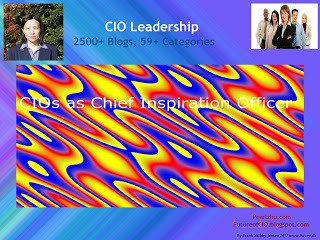To Celebrate the #2500th Blog Posting of “Future of CIO”
 In the industrial age, CIOs are the second class executive who often does not have a seat at the big table to make strategy, and who spends most of time and resource on “keeping the light on.” However, digital means the increasing speed of changes, data abundance, and hyperconnectivity, technology is often the very disrupter of innovation, and information is the lifeblood of organizations, many forward-thinking organizations empower their CIOs to be the frontrunner, digital transformer, recognize CIOs as communication hub and change agent due to the unique position they hold to oversight business processes, and interweave business capabilities. But how to run a high innovative, high-effective and high-mature IT organization with the very nature of digital “persona” and high influence? What are the bold imagination about the magic “I” in “CI”’s title, can IT play a pivotal role in digital transformation, run as an innovation engine of their organization. Here is the Sum Up posting to celebrate the #2500 blog posting of the “Future of CIO”:
In the industrial age, CIOs are the second class executive who often does not have a seat at the big table to make strategy, and who spends most of time and resource on “keeping the light on.” However, digital means the increasing speed of changes, data abundance, and hyperconnectivity, technology is often the very disrupter of innovation, and information is the lifeblood of organizations, many forward-thinking organizations empower their CIOs to be the frontrunner, digital transformer, recognize CIOs as communication hub and change agent due to the unique position they hold to oversight business processes, and interweave business capabilities. But how to run a high innovative, high-effective and high-mature IT organization with the very nature of digital “persona” and high influence? What are the bold imagination about the magic “I” in “CI”’s title, can IT play a pivotal role in digital transformation, run as an innovation engine of their organization. Here is the Sum Up posting to celebrate the #2500 blog posting of the “Future of CIO”:
“Future of CIO” 2500 Blog Posting Sum Up Slides: The future of CIO is entrepreneur driven, situation oriented, value-added, she or he will take many paradoxical roles: both as business strategist and technology visionary,talent master and effective communicator,savvy business enabler and relentless cost cutter, and transform the business into "Digital Master"!
The Digital Core (Digitalization/Digital Master Tuning) of “Future of CIO”, Slides, VIdeo: Due to the changing nature and continuous disruption of information and technology in business nowadays, CIOs seem to be always at hot seat, the saying about the demise of the internal IT has been around for years, the fact is that because of the pervasiveness of technology within the enterprise and radical digital transformation facing in majority of organizations today, there is now a greater need for a CIO to understand business drivers and apply digital technology to speed up IT and build business competitive capabilities. So CIO must go digital, like a Pro!
Digital Mindset: Slides, Video: Mind-set is far more important than talent. Talent can always be developed by those with an open and right mind-set. In chapter II of Digital Master, we introduce the 15 decoded ultramodern digital mind-sets, in the upcoming book, we will expand into 100+ digital minds.
CIO Leadership & The Future of Leadership Slides, Video: Modern CIOs have many personas and face numerous challenges. It is not sufficient to only keep the light on. Regardless of which industry or the nature of organization you are in, being a digital leader will need to master the art of creating unique, differentiating value from piles of commoditized technologies, but more specifically, what are the digital-savvy CIOs doing to run IT as a value creator and innovation engine?
IT Transformation (300+)In today's digital business environment, information is the lifeblood, and technology touches every phase and each corner of the business, IT running in an industrial mode as a business controller or a gatekeeper no longer fits in the fast changing business circumstances or volatile digital dynamic, how to run IT with the growth mentality at digital speed? How to improve IT organization's maturity, from a controller to an enabler; from a support function to an innovation engine; from monolithic technology-heavy to mosaic information-driven?
Information Management (300+) Information Management is to connect people with the right information at the right time & location, to ensure that accurate information is accessible and shared within relevant business units. This information is open to interpretation accordance to the level of knowledge one has. The value of information is qualitative, measurable, and defined uniquely to an organization. IT must bring to the table innovative solutions that meet customers’ needs, while reducing cost to market, without the sacrifice of strategic goals. If done well, information achieves its value
Strategy/Execution Continuum (300+): Digital strategy execution continuum is cross-functional effort and multidisciplinary, multidimensional planning; it brings up new functions, roles, and responsibilities, collaboration, demand for intuition and emergence, complementarities, philosophy, neutron sciences, and trans-disciplinary businesses. But these are not new per se. The frameworks of thoughts, consciousness and maturity assessments apply to strategy, then, now and in the future.IT Innovation Management (300+) From an innovation perspective, IT mantra is shifting from “doing more with less,” to “doing more with innovation.” However, running an innovative IT doesn't mean IT will go “wild,” or "rogue"; more about IT should go smarter and flexible; it doesn't mean IT should get rid of all those processes or IT framework hassles. In fact, creativity and process have to go hand in hand; without process there is chaos and from the chaos it’s hard to be creative.IT Talent Management (300+): People are always the most invaluable asset in businesses. “Hiring the right person to the right position at the right time,” is the mantra of many forward-thinking organizations. The question is how would you define the right people? How do you define wrong, average, mediocre, good, great or extraordinary person? Or put simply, for what should they be right? Traditional Performance Management focusing on measuring what an employee does (mainly being told to do) in a quantitative way is not sufficient to identify high performance or high potential, should we see through talent from different angles?Change is the very Nature of Digital (250+): Change is inevitable, and organizational change becomes a common practice within an organization, but more than two-thirds of change effort fail to achieve the expected results. What’re the barriers to cause the change failures, and how to make Change Management tangible rather than fluffy, and manage change lifecycle effectively?
 Blogging is not about writing, but about thinking and innovating the new ideas; it’s not just about WHAT to say, but about WHY to say, and HOW to say it. It reflects the color and shade of your thought patterns, and it indicates the peaks and curves of your thinking waves. Unlike pure entertainment, quality and professional content takes time for digesting, contemplation and engaging, and therefore, it takes the time to attract the "hungry minds" and the "deep souls." It’s the journey to amplify diverse voices and deepen digital footprints, and it's the way to harness your innovative spirit.Follow us at: @Pearl_Zhu
Blogging is not about writing, but about thinking and innovating the new ideas; it’s not just about WHAT to say, but about WHY to say, and HOW to say it. It reflects the color and shade of your thought patterns, and it indicates the peaks and curves of your thinking waves. Unlike pure entertainment, quality and professional content takes time for digesting, contemplation and engaging, and therefore, it takes the time to attract the "hungry minds" and the "deep souls." It’s the journey to amplify diverse voices and deepen digital footprints, and it's the way to harness your innovative spirit.Follow us at: @Pearl_Zhu
Published on January 18, 2016 22:17
No comments have been added yet.



